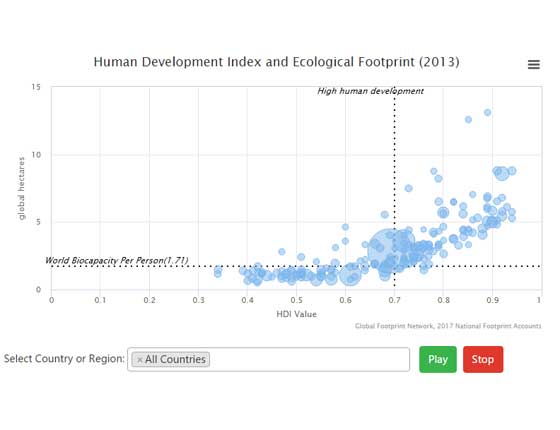OAKLAND, CA, USA—Eight countries in the world currently meet two key minimum conditions for global sustainable development: satisfactory well-being for their residents, as measured by the U.N., and living within the planet’s resource budget, according to Global Footprint Network, an international sustainability think tank with offices in North America, Europe and Asia. Global Footprint Network monitors this second condition by tracking humanity’s demand on the planet (Ecological Footprint) against nature’s ability to provide for this demand (biocapacity).
The findings come as 193 nations are meeting this week in New York to adopt Sustainable Development Goals (SDGs) to secure well-being for all on this one planet, regardless of income level, gender or ethnicity.
Mapping the sustainable development of nations
“Caring for the Earth,” the seminal 1991 report jointly issued by the International Union for the Conservation of Nature (IUCN), the U.N. Development Programme and WWF, provided the most specific definition of sustainable development: “improving the quality of human life while living within the carrying capacity of supporting eco-systems.”
“Fulfilling this universal dream requires progress without any additional costs for future generations. This means it will be crucial to manage natural resources carefully so that we live within the means of nature.”
—MATHIS WACKERNAGEL, President of Global Footprint Network.
The concept of “well-being for all” has its own U.N.-developed metric: the Human Development Index. HDI is based on the life expectancy, education and income of a nation’s residents. On a scale of zero to one, the U.N. Development Programme defines 0.7 as the threshold for a high level of development (0.8 for very high development.)
The concept “within the means of nature” is measured by the Ecological Footprint. The Footprint adds up the competing demands on productive surfaces, including food, fiber, timber, carbon dioxide sequestration and space for infrastructure.
At current population levels, our planet provides only 1.7 global hectares (gha) of biologically productive surface area per person. Thus, the average Ecological Footprint per person worldwide needs to fall significantly below this threshold if we want to accommodate larger human populations and also provide space for wild species to thrive.
Each nation’s endowment and ability to trade vary enormously. However, to achieve global sustainable development, with an HDI of at least 0.7, humanity’s demand on nature has to fall below an average of 1.7 gha per person, based on current population levels. While the HDI of most nations has been steadily increasing over the past decades, their Ecological Footprint has been growing as well. Humanity’s annual demand on nature currently exceeds what Earth can regenerate in that year by 60 percent.
While the HDI of most nations has been steadily increasing over the past decades, their Ecological Footprint has been growing as well. Humanity’s annual demand on nature currently exceeds what Earth can regenerate in that year by 60 percent.
Algeria, Colombia, Cuba, Ecuador, Georgia, Jamaica, Jordan and Sri Lanka are the only countries that currently meet the two minimum criteria for global sustainable development. They enjoy “high human development” (even “very high human development” in the case of Cuba) while keeping their Ecological Footprint lower than 1.7 global hectares per person, according to Global Footprint Network and United Nations data.
By contrast, both the United States and China meet the minimum HDI requirement, while missing the second criteria by exceeding the 1.7 gha per person Ecological Footprint level. In India, meanwhile, the Ecological Footprint per person is 0.9 gha, substantially lower than the 1.7 gha per person global threshold, and its HDI is only 0.58. (See sortable HDI-Footprint Chart for more than 150 countries.)
Resource risk is acute for 71% of the global population
However, growing population and increasing consumption continue adding pressure on ecological constraints and contributing to climate change, compounding resource risks for every country’s economy. Such risks are most evident in countries whose Ecological Footprints are larger than what their ecosystems can renew—these countries are running “ecological deficits”—and who have low incomes, and therefore can less easily afford to buy their way out of resource scarcity.
A staggering 71 percent of the world population now lives in countries with this double-challenge: ecological deficits AND lower-than-world-average income. That’s up from less than 15 percent in the early 1960s.
“Putting natural resource security squarely into the development equation will be essential to ensuring that sustainable development is achieved,” said Wackernagel. “We hope the Sustainable Development Goals will spur all of us to move forward along this path.”
Additional Resources:
Animated HDI-Footprint Graphic: 1980-2011
Ecological Footprint-HDI Sortable Chart
Downloadable Sustainable Development Poster
Free Public Data Package (Ecological Footprint Data on 200 countries)
About Global Footprint Network:
Global Footprint Network is an international think tank working to drive informed, sustainable policy decisions in a world of limited resources. Together with its partners, Global Footprint Network coordinates research, develops methodological standards, and provides decision-makers with a menu of tools to help the human economy operate within Earth’s ecological limits.


